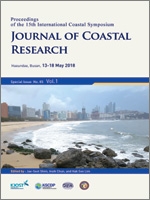Choi, J.-W.; Kwon, J.-I.; Heo, K.-Y.; Park, K.-S., and Choi, J.-Y., 2018. Accuracy improvement of particle-tracking simulation considering wind speed using various drift objects. In: Shim, J.-S.; Chun, I., and Lim, H.S. (eds.), Proceedings from the International Coastal Symposium (ICS) 2018 (Busan, Republic of Korea). Journal of Coastal Research, Special Issue No. 85, pp. 901–905. Coconut Creek (Florida), ISSN 0749-0208.
The simulation accuracy of the particle-tracking model (PTM) primarily depends on wind and current, among various parameters. This study explored the effect of wind on particle tracking using drift objects (drift buoy and mannequin). For numerical experiments, wind and current generated from the weather research and forecasting model (WRF) and Modelo Hidrodinâmico (MOHID) were used in the PTM. Furthermore, a field experiment was conducted using a surface drift buoy nearby Gageo Island, which is located on the south-western coast of the Korean Peninsula. Drifting buoy data from June to December 2015 were used and the PTM were calculated every 12 h. We firstly applied different wind factor values from 2% to 5% with 0.2% interval to estimate a single constant optimal wind factor, and subsequently, we applied different values according to wind speed. To determine the relationship between these factors, two important parameters, the maximum acceptable duration and accuracy (drifting object located within 1 km), were calculated from wind speeds of 2.5–10.0 m/s with 0.5 m/s interval. Using the derived wind factor (depending on wind speed), the accuracy of PTM was improved by about 10% compared to a single constant estimated optimal wind factor value of 3.2%. When this approach was applied to a mannequin type buoy, the accuracy was improved by about 9%. The results show that for practical application, the wind factor performs better as a function of wind speed, and not a single constant value.





